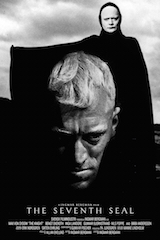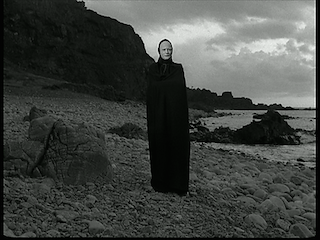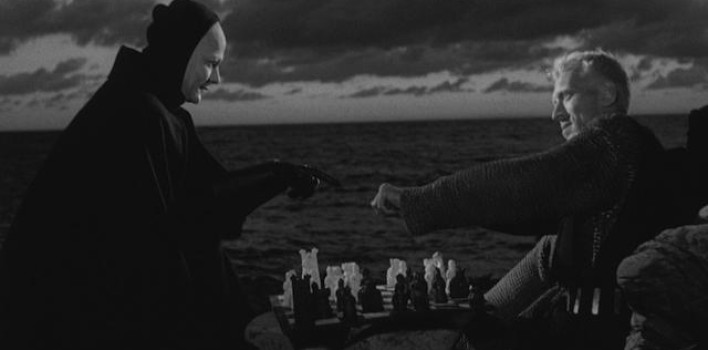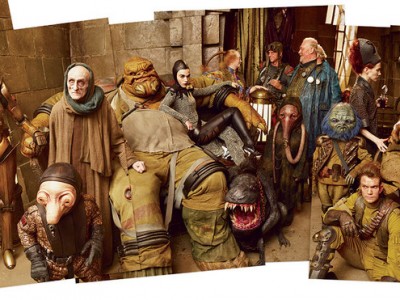Reviewing the Classics| The Seventh Seal
 Ingmar Bergman’s The Seventh Seal is a cliché. From the obvious choice of death as a skull-like specter, playing chess with death as a sort of “gentleman’s agreement” to delay the inevitable, to the dense dialogue and religious imagery, the movie is littered with references so overused we hardly can recognize them as unique or interesting anymore. The only problem with these first couple sentences is Bergman’s film was influential in birthing all of these now known clichés and popularizing these common metaphorical and allegorical tropes.
Ingmar Bergman’s The Seventh Seal is a cliché. From the obvious choice of death as a skull-like specter, playing chess with death as a sort of “gentleman’s agreement” to delay the inevitable, to the dense dialogue and religious imagery, the movie is littered with references so overused we hardly can recognize them as unique or interesting anymore. The only problem with these first couple sentences is Bergman’s film was influential in birthing all of these now known clichés and popularizing these common metaphorical and allegorical tropes.
Perhaps Bergman’s most well-known movie, it debuted in the United States in 1958. However, little was known of Bergman before its release. He had written and made a handful of movies, and gained some recognition at Cannes and in Europe. However, most movies imported from Europe were soft-core pornography films. In fact, Bergman’s most well-known movie before 1958, 1953’s Summer with Monika, was purchased for theatrical release in the US, edited down to 62 minutes to emphasize the nudity—the movie has less nudity than Tomb Raider— and repackaged as Monika, The Story of a Bad Girl. Before The Seventh Seal took arthouse theaters by storm, most Americans would have thought of Bergman as merely a pornographic European exploitation director.
The release of The Seventh Seal to American audiences was the beginning of both a turnaround for Bergman’s reputation in the US, as well as signaling a great change in the way Americans viewed European cinema. As Gary Giddins says in his essay, The Seventh Seal: There Go The Clowns, written for the Criterion release of the movie:
“[T]he effect of The Seventh Seal’s American debut…was transformative…cinema catapulted to the front line of a cultural advance guard that—shoulder to shoulder with modern jazz, abstract painting, Beat writing, theater of the absurd—sought to undermine the intractable mass taste promoted by Hollywood, television, and the Brill Building [site of the major recording studios of the time].”
Although his movie was often seen as difficult to understand, given audience tastes before this movie, the stunning imagery, and religious symbols captivated audiences.
The film begins with a black eagle floating over a beach and a portion of Revelation being read:
“And when the Lamb opened the seventh seal, there was silence in heaven about the space of half an hour… And the seven angels which had the seven trumpets prepared themselves to sound.” Revelation 8:1,6
After this opening narration, the camera flashes to a sweltering, stony beachfront that finds our main protagonist, the crusade-weary knight Antonius Block, played by the ever-aged Max Von Sydow, being met by the skull-like Bengt Ekerot as Death. In the most famous of imagery from the movie, Death has come for Block, only to have Block request a reprieve from death if he can best him in a gentleman’s game of chess.
After this opening scene, in keeping with the screenplay’s origins as a one-act play written by Bergman, the movie plays as a series of interconnected vignettes between Block and his Squire, Jöns, and another group of traveling performers; Jof, the juggler, his wife, Mia (Bibi Andersson), their son Mikael, and Jonas Skat, the leader of the troupe. Their fortunes will eventually lead them to travel together seeking shelter in Block’s castle-like manor and a respite from the constant reminder of death all around them from the Black Plague.
 However, death is their constant companion on their journeys. Either in the literal, personified form of Death himself or the skull mask Skat wears to scare the common folk. There is Jöns conversation with the fresco painter—“a skull is more interesting than a naked woman”—or the startling reminder through a roving band of flagellants insistent on repentance through self-flagellation and reenacting Christ’s passion in order to banish the plague which is interpreted as a sign of God’s judgment.
However, death is their constant companion on their journeys. Either in the literal, personified form of Death himself or the skull mask Skat wears to scare the common folk. There is Jöns conversation with the fresco painter—“a skull is more interesting than a naked woman”—or the startling reminder through a roving band of flagellants insistent on repentance through self-flagellation and reenacting Christ’s passion in order to banish the plague which is interpreted as a sign of God’s judgment.
An even more gripping reminder of death’s touch is when the whole group encounters a man in the forest infected with the Black Plague. As the group stays a healthy distance from the infected man, he wails for their help. Jöns handmaiden, whom he had rescued from an unsavory clergyman bent on violence towards her, is held back by Jöns as she desperately desires to help the poor man. “It’s useless, utterly useless,” he insists. There is nothing they can do for this poor man as he wails, “I’m afraid of dying!” and, “What will happen to me?” Eventually, he succumbs to the plague in front of them and serves as a poignant admonition to both the characters and the audience. Bergman puts his fears, dreams, and hopes on screen and it seems fairly obvious Bergman is the man screaming out existential and primordial howls as death overtakes this afflicted medieval man.
Block and Jöns engage this narrative struggle as differing polemicists; Block as a man yearning for concrete faith and Jöns as a ribald skeptic convinced of life as the greatest of triumphs and jaded by the virtues of love and compassion. Both wax about God’s seeming silence amidst suffering and death but meet their inevitable ends with differing demeanors and conclusions.
“Is it so terribly inconceivable to comprehend God with one’s senses? Why does he hide in a cloud of half-promises and unseen miracles? How can we believe in the faithful when we lack faith? What will happen to us who want to believe, but can not? What about those who neither want to nor can believe? Why can’t I kill God in me? Why does He live on in me in a humiliating way – despite my wanting to evict Him from my heart? Why is He, despite all, a mocking reality I can’t be rid of?” -Antonius Block
Block is the personification of modern man’s doubt. Not seen as a virtue, as some have argued, nor seen as an affliction. Block lives with doubt as a sort of primordial attribute. He earnestly desires faith, but he cannot bring himself to actually believe. He requires something more, something concrete. In the church scene where the above quote from Block is taken, he unknowingly speaks with death through the confessional and in the shadow of an artful crucifix and begs to have, “not assumptions, not faith, but knowledge.” He cries out with the man in Mark 9 when speaking to Jesus, “help my unbelief!” or with Job’s wife when she scolds her husband, “Curse God and die!” However, his cries and genuine inquiry are not from a place of belief, but from a place of hatred and self-loathing. Unable to connect with those around him, he is left to struggle alone for answers.
“Who will take care of that child? Is it the angels or God or Satan or the emptiness? The emptiness, Sire?” -Jöns
Conversely, Jöns, the squire, has seen his fair share of all manner of debauchery, mayhem, and pious attitudes. While Block struggles to find faith, Jöns has long since abandoned faith in favor of existential philosophizing and a nihilistic sense of humor. Jöns real contempt is for perhaps the greatest of virtues; love. Besides the aforementioned spurning of compassion for the man with the Black Plague—your survival instincts would keep you from being near a plague-ridden individual, as well—he is contemptuous of females and romantic love. His most sardonic and finest scenes are his interactions with Blacksmith Plog and his wife, the unfaithful Lisa. “Love,” he muses, “is the blackest of plagues,” and, “perfect in its imperfection.” His life experience and resulting cynicism have not led him to grasping at the infinite like his master, Block, but to a contentment in emptiness and prideful self-assurance. In one way, Jöns has banished the fear of death and accepted his fate by having processed and accepted the terror of the infinite.
 The final moments of both their lives and the immediate aftermath, seem to illustrate that Bergman has come down on the side of a nihilistic understanding of death. As Death has taken Jöns, Block, and their companions, Jof, who along with his wife and child escaped the fate of the others, sees a vision of the others engaged in the “Danse Macabre”, the Dance of Death, with Death as their strict lord. In the end, so it would go, the dance of death unites us all. A grim conclusion if there ever was one.
The final moments of both their lives and the immediate aftermath, seem to illustrate that Bergman has come down on the side of a nihilistic understanding of death. As Death has taken Jöns, Block, and their companions, Jof, who along with his wife and child escaped the fate of the others, sees a vision of the others engaged in the “Danse Macabre”, the Dance of Death, with Death as their strict lord. In the end, so it would go, the dance of death unites us all. A grim conclusion if there ever was one.
And yet, it is not the final shot of the movie. After this, we see Jof, his wife Mia, and their son Mikael embrace and ride off in their traveling wagon together as a family. They are the only ones left alive from out characters, but ultimately their final moment leaves us a much more helpful and hopeful picture. Their familial love, a collective compassion, and care for one another, echoes the Apostle John:
“There is no fear in love, but perfect love casts out fear.” 1 John 4:18 (NIV)
It is the antidote to Jöns poisonous, oily response to love and compassion. In fact, Block, often Jöns opposite, has experienced this love intimately. In an affecting scene at the midway point of the film, when our group first meets, Block sits with Mia, Mikael, and Jof and enjoys a quiet moment with them.
“I shall remember this moment: the silence, the twilight, the bowl of strawberries, the bowl of milk. Your faces in the evening light. Mikael asleep, Jof with his lyre. I shall try to remember our talk. I shall carry this memory carefully in my hands as if it were a bowl brimful of fresh milk. It will be a sign to me, and a great sufficiency.” -Antonius Block
In the shot itself, death has been banished to the background, as Skat’s skull mask hangs from the wagon out of focus. In the foreground is Block and the others sharing the moment. Fear of death has been abandoned and cast out in the face of a power much greater than either fear or death; love. And it is not just a romantic love or moderate affection, but a deep, abiding love that connects us deeply to others. It is though this connection to one another that we stand to banish the fear of death. And like Jof, the true moral center of the film, it is through a simple faith in Christ, who first loved us, and commitment to one another that we experience this love.







